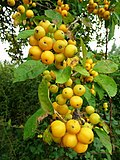| Malus angustifolia | |
|---|---|
| Scientific classification | |
| Kingdom: | Plantae |
| Clade: | Tracheophytes |
| Clade: | Angiosperms |
| Clade: | Eudicots |
| Clade: | Rosids |
| Order: | Rosales |
| Family: | Rosaceae |
| Genus: | Malus |
| Species: | M. angustifolia
|
| Binomial name | |
| Malus angustifolia | |

| |
| Natural range | |
| Synonyms[2] | |
| |
Malus angustifolia, or southern crabapple,[3] is a species of crabapple native to the eastern and south-central United States.
Description
[edit]M. angustifolia is a tree sometimes attaining a height of 10 meters (33 feet). The trunk can have a diameter up to 25 centimeters (10 inches). The flowers are pink, with a pleasant scent. The fruits are up to 3 cm (1+1⁄4 in) in diameter, and have an aromatic scent and a pear-like shape.[4][5]
Taxonomy
[edit]The following two varieties are known:[2]
- Malus angustifolia var. angustifolia
- Malus angustifolia var. puberula (Rehder) Rehder
Distribution and habitat
[edit]The species can be found from Florida west to eastern Texas and north to New Jersey, Pennsylvania, Illinois and Missouri.[6]
M. angustifolia prefers habitats that are moist but well-drained. For inflorescence to occur, full sunlight is required.[7] The species has been observed in habitat types such as dry hammocks, xeric flatwoods, mesic woodlands, floodplains, and pine woods.[8][9]
Ecology
[edit]The fruits are eaten by various wildlife.[10]
Uses
[edit]Although the fruits are astringent, acidic, and unpalatable when raw, they can be used to make jellies, jams, and food preserves.[4][5]
The tree is grown as an ornamental plant.[citation needed]
References
[edit]- ^ IUCN SSC Global Tree Specialist Group.; Botanic Gardens Conservation International; et al. (BGCI) (2020). "Malus angustifolia". IUCN Red List of Threatened Species. 2020: e.T64134490A152906529. doi:10.2305/IUCN.UK.2020-1.RLTS.T64134490A152906529.en. Retrieved 19 November 2021.
- ^ a b The Plant List, Malus angustifolia (Aiton) Michx.
- ^ "Search results for: Malus". Archived from the original on April 4, 2010. Retrieved September 11, 2009.
- ^ a b Flora of North America, Malus angustifolia (Aiton) Michaux, 1803. Southern or narrow-leaved crabapple
- ^ a b Malus angustifolia at Plants for a Future
- ^ Biota of North America Program, 2014 county distribution map
- ^ "USDA Plants Database". plants.usda.gov. Retrieved 2025-08-08.
- ^ Weakley, A.S. 2020. Flora of the Southeastern United States. Edition of 20 October 2020. University of North Carolina at Chapel Hill, Chapel Hill, North Carolina.
- ^ Florida State University Robert K. Godfrey Herbarium database. URL: http://herbarium.bio.fsu.edu. Last accessed: June 2018. Collectors: Loran C. Anderson, R.K. Godfrey, Patricia Elliot, John C. Ogden, R L Lazor, L R Fox, K Craddock Burks, Gary R Knight, R A Norris, M R Darst, R Komarek, H Roth, M Jenkins, Elmar C Prichard. States and counties: Florida (Wakulla, Leon, Gadsden, Jefferson, Liberty, Washington), Georgia (Thomas, Grady), North Carolina (Cumberland).
- ^ Little, Elbert L. (1980). The Audubon Society Field Guide to North American Trees: Eastern Region. New York: Knopf. p. 489. ISBN 0-394-50760-6.
External links
[edit]- Carolina Nature
- Lady Bird Johnson Wildflower Center, University of Texas
- Louisiana Plant Identification
- Leafsnap.com: Images of the Southern Crabapple (Malus angustifolia)

